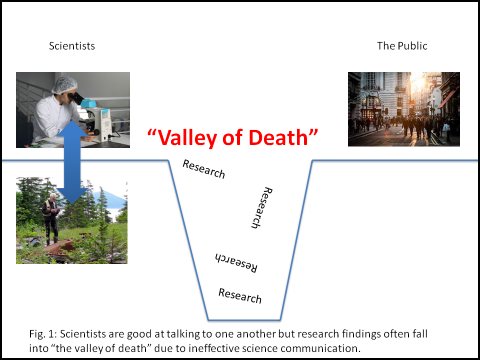
By Caitlin Maloney, ArbNet intern, The Morton Arbortum
Opportunities and Benefits of Science Communication
Collectively, arboreta have millions of visitors each year. Many of these arboreta are active in tree research and conservation, but is this information reaching important audiences? Effective science communication can provide opportunities for funding, help to recruit potential students, and ultimately give arboreta a greater voice in the scientific and non-scientific communities. Museums and science centers, like arboreta, are more trusted sources of scientific information by the public compared to general news sources, however arboreta are not where people seek out the majority of their science news (Funk et al. 2016). In fact most Americans find their news on social media (Shearer and Gottfried 2017). In order to change this, we wanted to understand how arboreta were communicating their research, if there was a gap in communication of research between scientists and the public (known as the “Valley of Death”) (Fig.1), and create a resource for sharing tree research with your audience. Whether or not you participate in tree research and conservation, your arboretum can be a leader in science communication.
Quantifying Science Communication at Arboreta
To quantify the “Valley of Death” we compared the research that ArbNet accredited arboreta stated they were doing in their accreditation application with the research they posted on their websites and social media platforms. We evaluated:
- Their website, by searching for scientific research content using the “3-click-rule”. If it took us more than three clicks to find the items below it was not easily accessible to the public:
- Mention of the arboretum’s research
- Scientific publications related to tree research
- Press releases related to current or published tree research
- Their social media platforms (Facebook, Twitter, and Instagram) where we used the search terms:
- “Research”
- “Science” and “scientist”
- “Conservation”
- “Data”
This evaluation focuses on the 35 level III and level IV accredited arboreta, because they are required to outline their tree science and research programs in the accreditation application. In the future, we will extend this evaluation to level I and II arboreta.
Results
In total 15 of 17 (88%) level III and 20 of 20 (100%) level IV arboreta reported doing research on their application. Of those arboreta reporting research, 9 of 15 (60%) level III and 16 of 20 (80%) level IV arboreta clearly advertise their research on their website (Fig. 2), and only eight arboreta advertise research-based press releases on their website.
Next, we evaluated how arboreta were using their social media channels. Most of the level III and level IV arboreta that do research are actively using Facebook, Twitter, and/or Instagram. However, only 19 of the 35 arboreta (54%) that report doing research posted about it on social media within the past six months (Fig. 3), and only 5 of those 19 (26%) had more than 10 posts within the past six months.
Overall, there is a clear need for arboreta to overcome the “Valley of Death” by improving their science communication to a broad public audience. Because arboreta are viewed as trusted scientific institutions by the general public, there is a great opportunity to provide valuable tree research information to the millions of visitors who enjoy your gardens every year. By advertising research on our website and social media platforms, we can work to increase scientific literacy and inspire tree advocates.
Steps arboreta can take to improve their science communication
- Identify your target audience: There is no such thing as a homogenous “general public.” Instead, individuals with different backgrounds and beliefs make up your audience. Identifying your audience can help you focus your message toward those individuals through the most effective outlet.
Potential audience:
- Other scientists
- Visitors/members of your arboretum
- Students
- Science-affinitive individuals
- Social media users
- Develop a social media presence: Two-thirds of Americans get their news from social media rather than traditional news sources (Shearer and Gottfried 2017). This is a tremendous opportunity for arboreta to access a larger group of people by sharing their news via social media. Even if your arboretum is not actively participating in research, you can still be a leader in science communication by sharing other sources of tree science news.
- If you have an active social media site, begin highlighting science and research happening at your arboretum, or relevant news stories from other arboreta and trusted media outlets.
- If your arboretum does not use a social media site, starting one can help you connect with your visitors, advertise your events, and share information about science and conservation happening at your institution.
- Advertise your research on your site: Many arboreta are doing research, but unless it can be found on a website ‘in three clicks,’ it is not easy to find.
- Implement a 3 click rule on your own website to make your research accessible (Krug 2014).
- Add a search bar so visitors can easily find what they need on your site.
- If possible, include a tab dedicated to research and conservation. This is an easy way to advertise for visitors.
References and Helpful Links
AAAS Center for Public Engagement with Science Technology
Dahlstrom. M.F. 2014. Using narratives and storytelling to communicate science with non-expert audiences. PNAS. 111: 13614–13620.
Funk, C., Gottfried, J., Mitchell A. 2017. “Science News and Information Today”. Pew Research Center. Journalism and Media. http://www.journalism.org/2017/09/20/science-news-and-information-today/
Krug, Steve, author. (2014). Don't make me think, revisited : a common sense approach to Web usability. [Berkeley, Calif.] :New Riders.
Marlon, J., Howe, P., Mildenberger, M., Leiserowitz, A. “Yale Climate Opinion Maps – U.S. 2016”. Yale Program on Climate Change Communication. http://climatecommunication.yale.edu/visualizations-data/ycom-us-2016/?est=happening&type=value&geo=county
Shearer, E. Gottfried, J., 2017. “News Across Social Media”. Pew Research Center. Journalism and Media.http://www.journalism.org/2017/09/07/news-use-across-social-media-platforms-2017/

